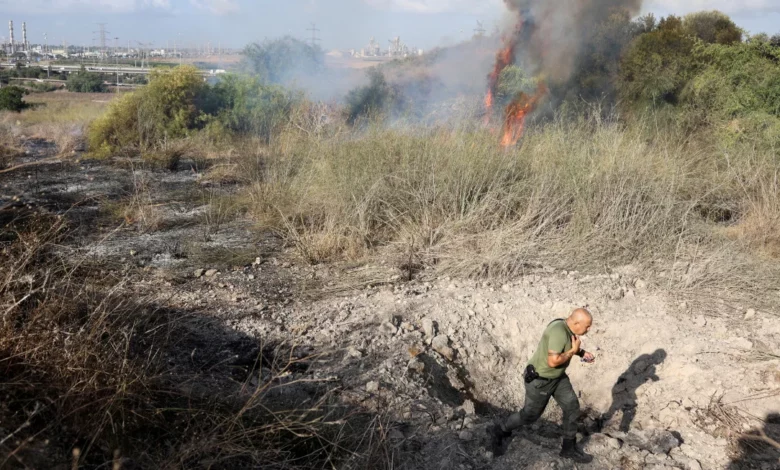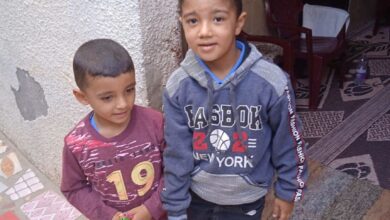
The projectile was fired from Yemen toward Israel at 6am local time this morning, according to the Israel Defense Forces who added that it “most likely fragmented in mid-air.” The missile fell in an open area in central Israel, with no injuries reported.
Videos and images shared by the Israel Fire and Rescue Authority on Telegram show large plumes of smoke billowing into the air over an open field, and shattered glass inside a train station in Modi’in, a city between Tel Aviv and Jerusalem.
A spokesman for the Iran-backed Huthis military spokesman confirmed the attack, claiming that the group used a “new hypersonic ballistic missile” and warning that Israel should expect more such strikes as the first anniversary of the October 7 attack by Hamas approaches.
Despite months of tensions it is a rare instance of a missile penetrating as far as central Israel, normally safe for civilians.
“We are in a multi-arena campaign against Iran’s evil axis that strives to destroy us,” said Netanyahu, speaking ahead of a cabinet meeting.
“They should have known by now that we exact a heavy price for any attempt to harm us,” he added, referencing the Israeli attack on the Yemeni port of Hodeidah in July which followed a deadly drone attack on Tel Aviv.
Israeli police said they were working with the police bomb squad in the Shfela area, also known as the Judaean Foothills, where an interceptor fragment had fallen. Authorities are now isolating the impact site and scanning for additional interceptor remains, police said.
Sirens rang across central and northern Israel, the military said, and sirens were also sounded at Tel Aviv airport, the airport’s spokesperson told CNN. Videos on social media showed passengers running to find shelter.
Also on Sunday morning, approximately 40 projectiles crossed from Lebanon into Israel’s northern region, some of them intercepted and others falling in open areas, the IDF said. No injuries were reported, and authorities are putting out fires caused by the fallen projectiles.
Hezbollah has been firing almost daily barrages of projectiles and drones into Israel. “The existing reality will not continue,” said Netanyahu, adding that a “change in the balance of power” is needed at the northern border to ensure residents could return home.
The IDF meanwhile opened an investigation following reports that leaflets were dropped in southern Lebanon warning civilians to leave.
The leaflets, written in Arabic and found in the area of Wazzani, a village within a few kilometers of the border with Israel, told residents that Hezbollah was firing from their area and that they should “not come back to this area until the end of the war.”
The IDF said in a statement Sunday that the disperal of leaflets was “an independent initiative of the 769th Brigade in the Northern Command,” and was not approved by the IDF’s high command.
Fears of escalation
Tensions between Israel, Yemen and Lebanon have been escalating for months as Israel has waged its war on Hamas in Gaza after the militant group’s October 7 attacks. World leaders have warned of the potential for a wider Middle East conflict.
Since the war began, the Iran-backed Huthi group, which controls Yemen’s most populous regions, has regularly targeted Israel with drones and missiles. Most of these have been intercepted by Israel’s defenses or those of its allies.
It has also targeted shipping in the Red Sea, as a rejection of Israel’s military campaign in Gaza.
Most notably in July, the group claimed responsibility for a deadly drone attack in Tel Aviv, Israel’s commercial center – the first time the city has been struck by a Huthi drone.
Israel struck back the next day with deadly airstrikes on a Yemeni port – the first such strike on Yemen, according to Israeli officials.
The Iran-backed militant group Hezbollah in Lebanon has also carried out attacks on northern Israel, sending rockets and drones on Saturday targeting Israeli military sites.
These direct attacks on each other’s soil have raised alarm that there could be a new front in the ongoing conflict, which is already threatening to spill over across the region.
Israel launched its war in Gaza after the militant group Hamas’ cross-border October 7 attacks, in which more than 1,200 Israelis were killed and 250 taken hostage, according to Israeli authorities.
Since then, more than 41,000 Palestinians have been killed in Israel’s military operations in Gaza, according to the health ministry in the enclave. The health ministry does not distinguish between combatants and civilians in its figures, but says most of the dead are women and children.




